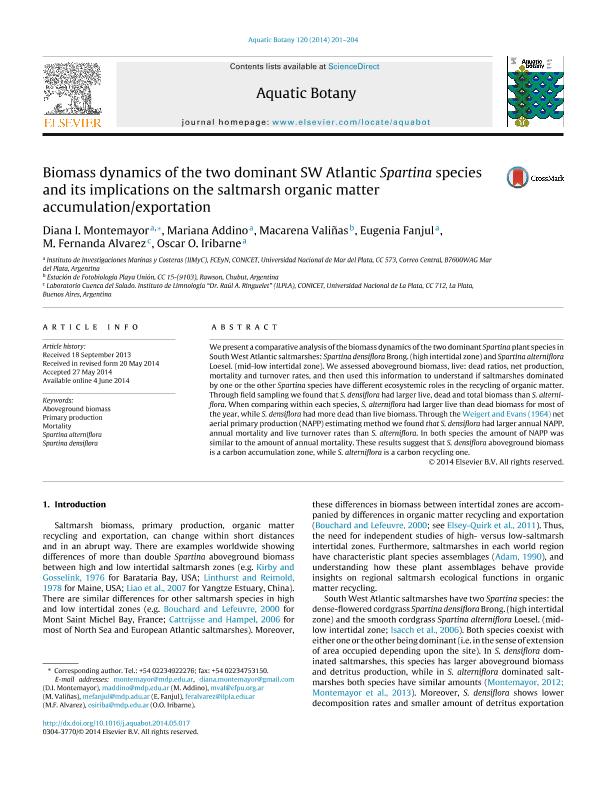Artículo
Biomass dynamics of the two dominant SW Atlantic Spartina species and its implications on the saltmarsh organic matter accumulation/exportation
Montemayor Borsinger, Diana Ireri ; Addino, Mariana del Sol
; Addino, Mariana del Sol ; Valiñas, Macarena Soledad
; Valiñas, Macarena Soledad ; Fanjul, Maria Eugenia
; Fanjul, Maria Eugenia ; Alvarez, María Fernanda
; Alvarez, María Fernanda ; Iribarne, Oscar Osvaldo
; Iribarne, Oscar Osvaldo
 ; Addino, Mariana del Sol
; Addino, Mariana del Sol ; Valiñas, Macarena Soledad
; Valiñas, Macarena Soledad ; Fanjul, Maria Eugenia
; Fanjul, Maria Eugenia ; Alvarez, María Fernanda
; Alvarez, María Fernanda ; Iribarne, Oscar Osvaldo
; Iribarne, Oscar Osvaldo
Fecha de publicación:
04/06/2014
Editorial:
Elsevier Science
Revista:
Aquatic Botany
ISSN:
0304-3770
Idioma:
Inglés
Tipo de recurso:
Artículo publicado
Clasificación temática:
Resumen
We present a comparative analysis of the biomass dynamics of the two dominant Spartina plant species in South West Atlantic saltmarshes: Spartina densiflora Brong. (high intertidal zone) and Spartina alterniflora Loesel. (mid-low intertidal zone). We assessed aboveground biomass, live: dead ratios, net production, mortality and turnover rates, and then used this information to understand if saltmarshes dominated by one or the other Spartina species have different ecosystemic roles in the recycling of organic matter. Through field sampling we found that S. densiflora had larger live, dead and total biomass than S. alterni- flora. When comparing within each species, S. alterniflora had larger live than dead biomass for most of the year, while S. densiflora had more dead than live biomass. Through the Weigert and Evans (1964) net aerial primary production (NAPP) estimating method we found that S. densiflora had larger annual NAPP, annual mortality and live turnover rates than S. alterniflora. In both species the amount of NAPP was similar to the amount of annual mortality. These results suggest that S. densiflora aboveground biomass is a carbon accumulation zone, while S. alterniflora is a carbon recycling one.
Archivos asociados
Licencia
Identificadores
Colecciones
Articulos(IIMYC)
Articulos de INSTITUTO DE INVESTIGACIONES MARINAS Y COSTERAS
Articulos de INSTITUTO DE INVESTIGACIONES MARINAS Y COSTERAS
Articulos(ILPLA)
Articulos de INST.DE LIMNOLOGIA "DR. RAUL A. RINGUELET"
Articulos de INST.DE LIMNOLOGIA "DR. RAUL A. RINGUELET"
Citación
Montemayor Borsinger, Diana Ireri; Addino, Mariana del Sol; Valiñas, Macarena Soledad; Fanjul, Maria Eugenia; Alvarez, María Fernanda; et al.; Biomass dynamics of the two dominant SW Atlantic Spartina species and its implications on the saltmarsh organic matter accumulation/exportation; Elsevier Science; Aquatic Botany; 120; part B; 4-6-2014; 201-204
Compartir
Altmétricas



